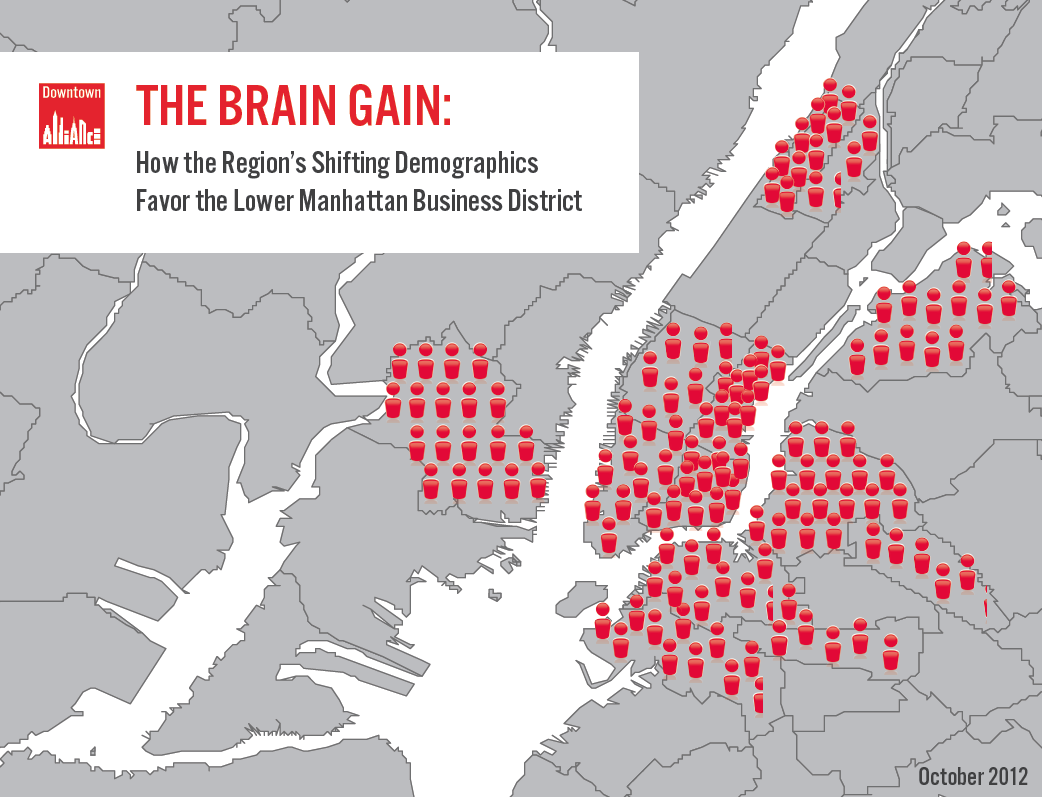Lower Manhattan Continues as Epicenter of Innovation and Economic Growth by Drawing Highly Skilled, Creative Talent

The Downtown Alliance today released a newly updated research report that demonstrates continued impressive growth in high-value professionals living within a 30-minute commute of Lower Manhattan. The data is also featured in a video, also released today. The Brain Gain clearly shows how shifting demographics have continued to favor the Lower Manhattan Central Business District over the past five years. The report is a testament to the forces that have shaped the remarkable recovery and transformation of Lower Manhattan over the past 14 years.
New data demonstrates that these demographic changes, first analyzed by the Downtown Alliance in 2012, have continued, resulting in an increasing share of the New York City metro region’s high value workers living within a 30-minute commute to Lower Manhattan. Specifically, more than 750,000 college-educated adults now live within a 30 minute commute. Creative and professional workers have experienced significant growth, with more than half a million people working in these industries now living within a 30 minute commute, an 18 percent increase since 2000.
College educated adults and creative and professional workers have continued to flock to areas nearby Lower Manhattan, demonstrating steady and accelerated growth. A quarter of the region’s college educated adults now live within 30 minutes of Lower Manhattan, an increase of more than 43,000 from 2010 to 2013. 24 percent of the region’s creative and professional workers live within 30 minutes of Lower Manhattan, and increase of more than 23,000 for the same time period. Comparatively, these populations have remained stagnant or declined in many other parts of the region.
“Lower Manhattan is an exciting, accessible place to work. That’s why we’re seeing the continued growth in businesses that depend on dynamic high-value workers,” said Downtown Alliance President Jessica Lappin. “To attract the best and brightest, this is where companies are looking. This is the epicenter of growth, of the strongest talent, and we’re thrilled to see these demographic trends proving their staying power.”
A major driving force of this growth is Lower Manhattan’s access to a wealth of transportation options. Serving 127 million annual riders, Lower Manhattan transit network includes 12 subway lines, 30 bus routes and 1 SBS route, 20 ferry routes, 2 PATH routes, 7 Downtown Connection buses and 28 CitiBike stations. Nearly 40 percent of the region’s college educated adults and more than one-third of the region’s creative and professional workers are within a one-seat ride to the district.
The Brain Gain is an analysis of 2000 U.S. Census and 2010 and 2013 American Community Survey data. The study area includes 30 counties in New York City’s five boroughs, Long Island, Westchester, the Hudson Valley, Southern Connecticut, Northeastern Pennsylvania and Northern New Jersey. The full report can be viewed here and The Brain Gain video can be viewed here.